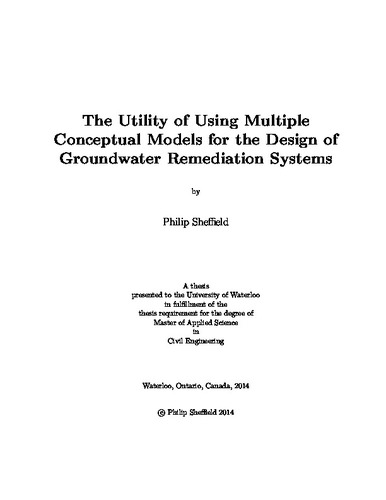| dc.description.abstract | The design of pump and treat systems for groundwater remediation is often aided by
numerical groundwater modelling. Model predictions are uncertain, with this uncertainty
resulting from unknown parameter values, model structure and future system forcings.
Researchers have begun to suggest that uncertainty in groundwater model predictions is largely dominated by structural/conceptual model uncertainty and that multiple conceptual
models be developed in order to characterize this uncertainty. As regulatory bodies
begin to endorse the more expensive multiple conceptual model approach, it is useful to
assess whether a multiple model approach provides a signi cant improvement over a conventional single model approach for pump and treat system design, supplemented with a factor of safety. To investigate this question, a case study located in Tacoma, Washington which was provided by Conestoga-Rovers & Associates (CRA) was used.
Twelve conceptual models were developed to represent conceptual model uncertainty
at the Tacoma, Washington site and a pump and treat system was optimally designed for each conceptual model. Each design was tested across all 12 conceptual models with no factor of safety applied, and a factor of safety of 1.5 and 2 applied. Adding a factor of safety of 1.5 decreased the risk of containment failure to 15 percent, compared to 21 percent with no factor of safety. Increasing the factor of safety from 1.5 to 2 further reduced the risk of containment failure to 9 percent, indicating that the application of a factor of safety reduces the risk of design failure at a cost directly proportional to the value of the factor of safety.
To provide a relatively independent estimate of a factor of safety approach a single
"best" model developed by CRA was compared against the multiple model approach.
With a factor of safety of 1.5 or greater, adequate capture was demonstrated across all
12 conceptual models. This demonstrated that in this case using the single \best" model developed by CRA with a factor of safety would have been a reasonable surrogate for a multiple model approach. This is of practical importance to engineers as it demonstrates that the a conventional single model approach may be su cient. However, it is essential that the model used is a good model. Furthermore, a multiple model approach will likely be an excessive burden in cases such as pump and treat system design, where the cost of failure is low as the system can be adjusted during operation to respond to new data. This may not be the case for remedial systems with high capital costs such as permeable reactive barriers, which cannot be easily adjusted. | en |

